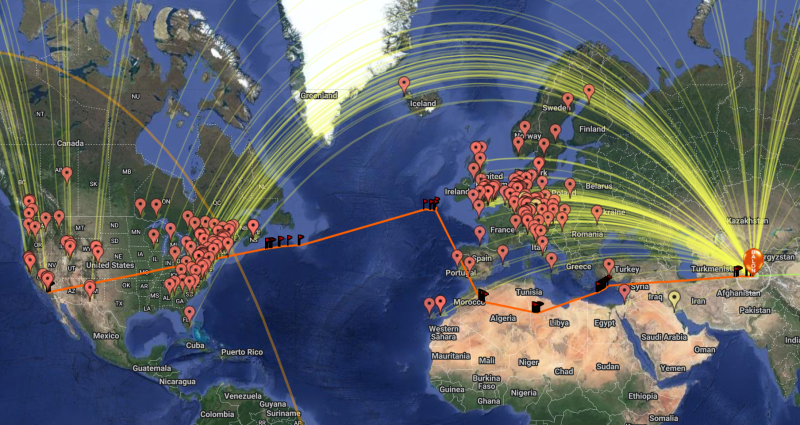[Martin Rothfield] and other amateur radio operators from San Francisco High Altitude Ballooning (SF-HAB) treated conference attendees to the 2022 Hackaday Supercon to the launch of two High Altitude Balloons (HABs). On the morning of November 6th, the two balloons were launched from a park across the street from Supplyframe DesignLab in Pasadena, California.
Seven days after its launch from Southern California, one of the balloons was over Tajikistan cruising eastward at an altitude of 42,000 feet (12,800 meters). Balloon W6MRR-26 was already approaching China where it will continue its wonderful world tour to parts unknown. The second balloon (call sign W3HAC-11) landed in northern Arizona where it has continued transmitting whenever it receives power from the sun.
Each balloon carries a tiny payload — a printed circuit board powered only by small photovoltaic cells. The board includes a microcontroller, a GPS module, and a Weak Signal Propagation Reporter (WSPR) radio transmitter. The transmitted operates on the 20 meter amateur radio band at around 14 MHz.
WSPR beacons can provide time, altitude, and location information. The WSPR telemetry is then relayed via WSPRgates using Automatic Packet Reporting System (APRS) onto the Internet. The collected information can be viewed and mapped on websites such as aprs.fi.
Map image from LU7AA AMSAT Argentina















Readers may be interested to know that my U4B high altitude balloon tracker is now available at http://qrp-labs.com/u4b – weighing 1.8 grams and costing $56.09 it is both the lightest and cheapest tracker available, by far.
U4B can be simply flown as is, with a complete end-to-end tracking solution on the QRP Labs website. Or if you wish you can flexibility program it in BASIC to enhance its capabilities (just connect a terminal emulator, no other hardware or software required). It has 19 GPIO pins and an I2C bus, ready to connect further sensors, whatever. You can even collect the data via the WSPR network telemetry system I developed, without any intervention or decoding yourself, using the tracking system on the QRP Labs website.
Our best test flight completed, if I recall, 18 laps of the world and flew for over 10 months. All on a pair of $1.50 AliExpress balloons. There’s a lot of data on the website http://qrp-labs.com/flights
These guys also launch wspr balloons quite often that travel around the world.
http://ham-tv.com/balloon/
This was great fun, and timing worked out really well to launch in front of a bit of audience waiting to get in to Supercon6. Thanks Martin for bringing TWO balloons (W3HAC & W6MRR) and KN6KZF for launch assist. W3HAC made it to the Grand Canyon, and looks like Tajikistan might be the last we hear of that one.
We also had a great launch from Hayward this last Sunday, and that 100g latex balloon made it to Phoenix Arizona. I’ve been out scooping up downed weather balloons, over 10 this last week. More to come on that, check out https://sondehub.org (particularly 00:00-02:00 & 12:00-14:00 UTC) for balloons that might in your area!
One would think the balloon approaching china would be giving someone fits.
One is okay. 98 more and we have a problem.
especially if they’re red.
This is really cool, although I imagine dealing with FAA/international aviation authorities must be a headache!
Could they put a repeater on this?
I’m curious about the liability should one of these balloons damage something in the air or on the ground. Can any of you enlighten me?
Well, with enough helium and large enough balloons, we could “enlighten” you a lot!
B^)
is any alternative for APRS for people without ham licence?
433MHz Lora, PMR, CB-Radio etc.
digital short packet
easy enough to get a Ham License. Tech class will work for UHF/VHF freqs.
The advantage with APRS is you have a ready-existing network of receivers listening and reporting via the internet. If you tried to roll it yourself with some other kind of radio you would need to either populate the planet with listening posts yourself or have enough power on the balloon to call all the way back home.
This only requires a tech license. Those are pretty easy to get.
“easy enough to get a Ham License”
Yep… 2 UPC’s from “Cracker Jack” boxes.
My dogs can get a license now.(they are smart dogs :) )
The last report on apps.fi for W6MRR-26 was on 11/16. I would love to hear more from this balloon’s radio.
Hopefully they haven’t been shot down by sidewinder missiles…